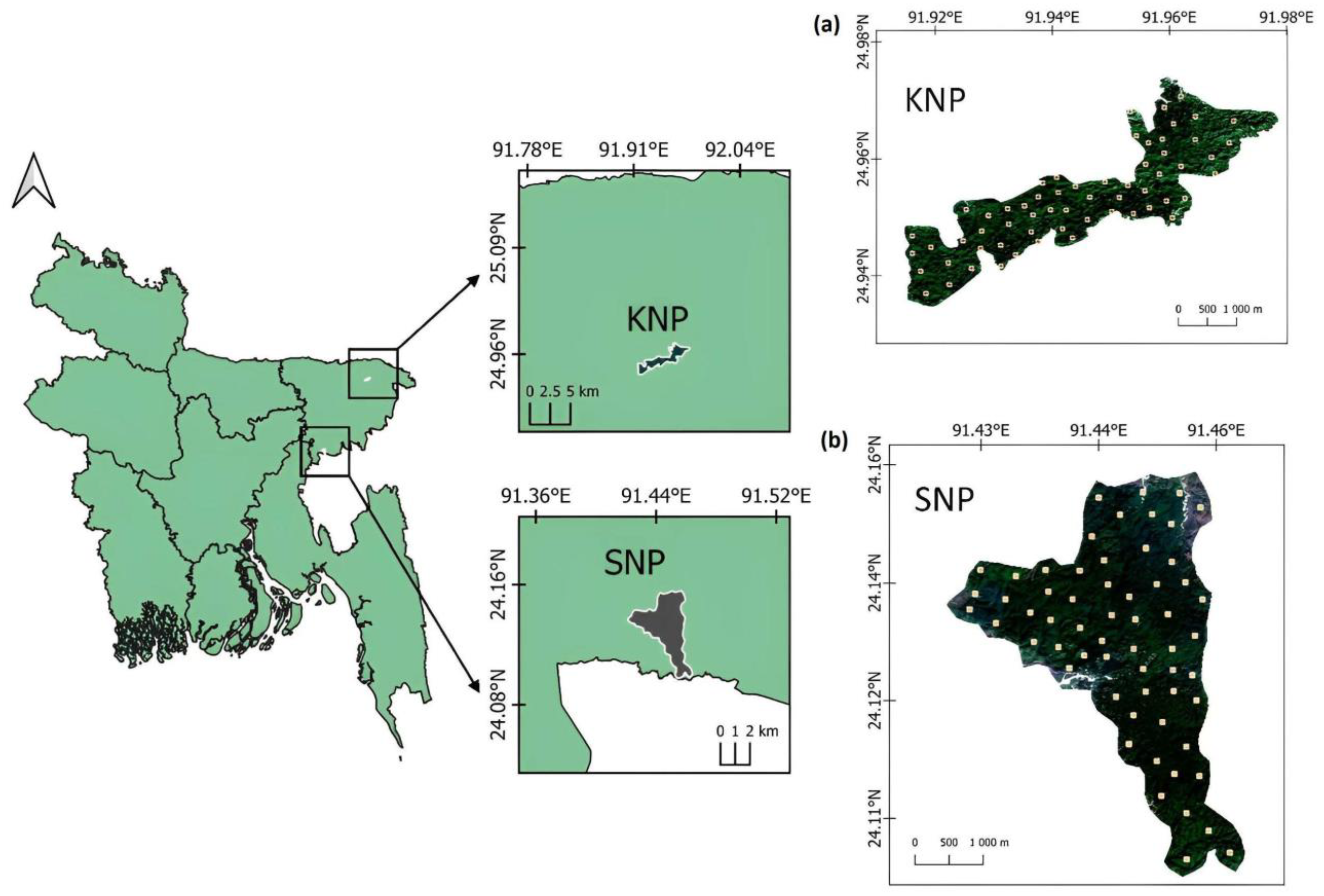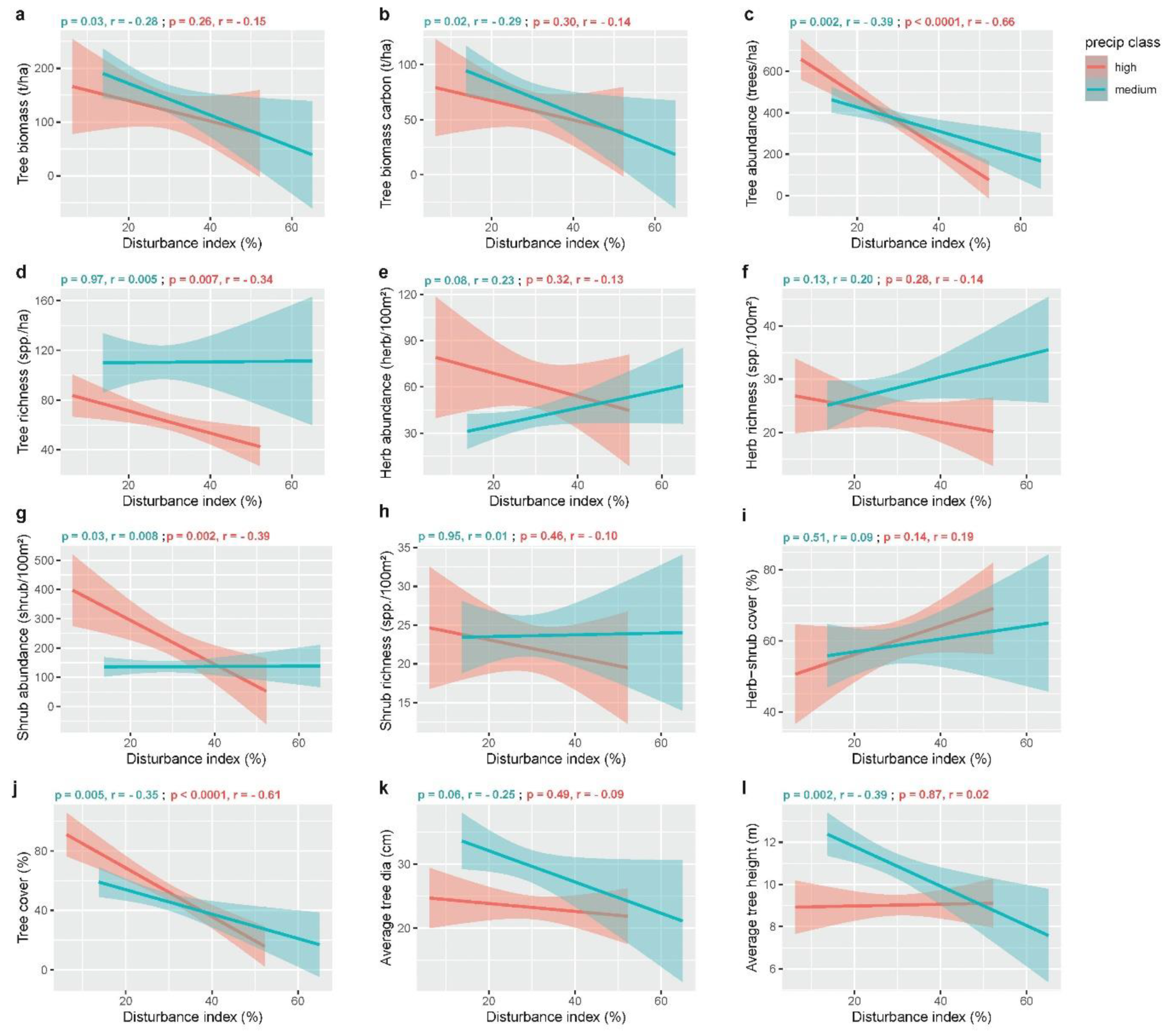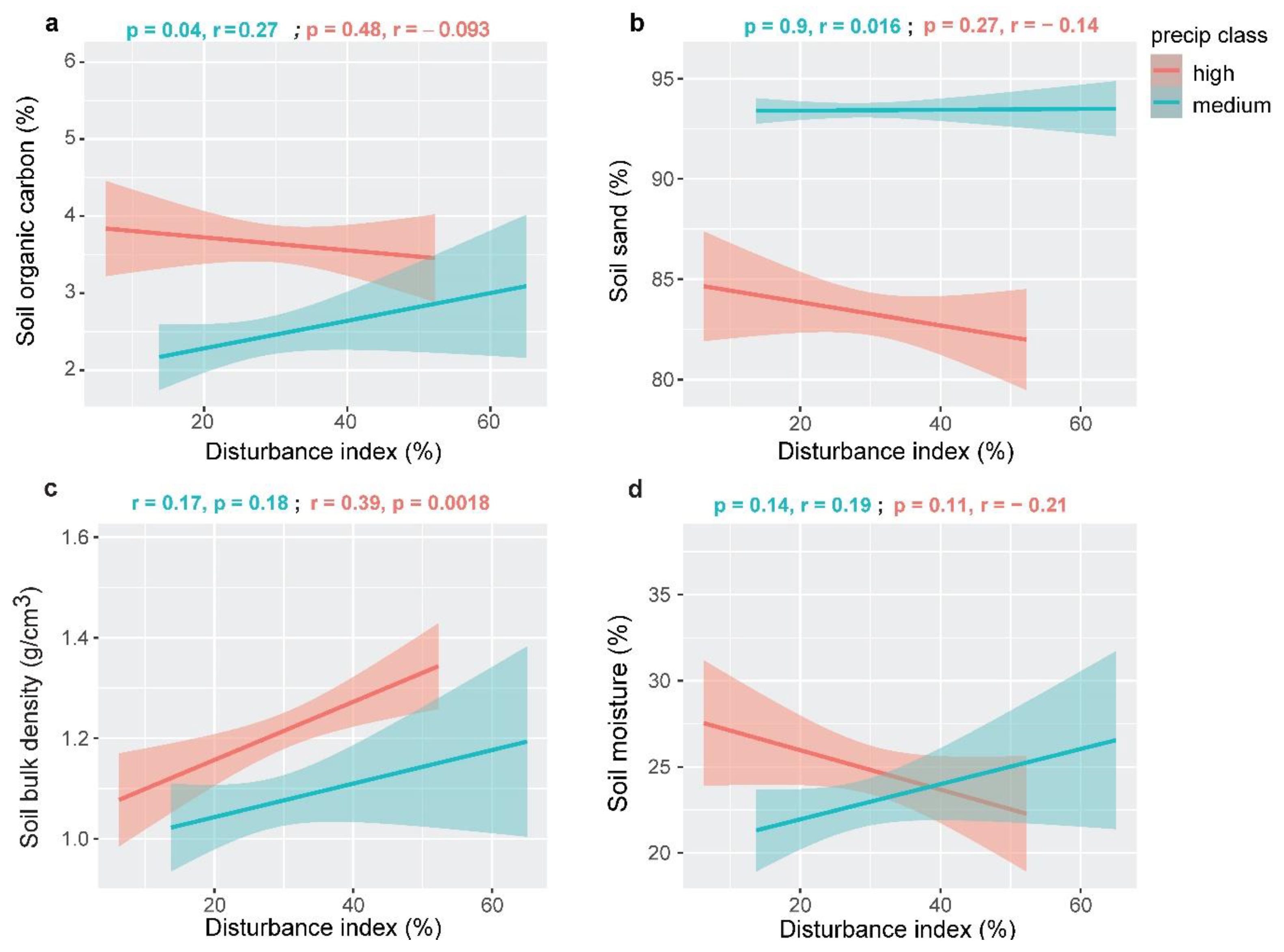Rainfall Modifies the Disturbance Effects on Regulating Ecosystem Services in Tropical Forests of Bangladesh
Abstract
1. Introduction
2. Materials and Methods
2.1. The Study Area
2.2. Sampling Design and Plot Selection
2.3. Indicators of Forest Ecosystem Services
2.4. Assessment of Disturbance and Ecosystem Services
2.4.1. Field Data Collection
2.4.2. Anthropogenic Disturbance Index
2.4.3. Estimation of Tree Biomass and Carbon Stock
2.4.4. Soil Sample Analysis and Organic Carbon Estimation
2.5. Statistical Analysis
3. Results
3.1. Aboveground Ecosystem Services
3.1.1. Primary Production
3.1.2. Tree Carbon Storage
3.1.3. Biodiversity Conservation
3.1.4. Wildlife Habitat
3.1.5. Timber Production
3.2. Belowground Ecosystem Services
3.2.1. Soil Organic Carbon Storage
3.2.2. Soil Aggregate Stability
3.2.3. Soil Physical Support
3.2.4. Soil Water Regulation
4. Discussion
4.1. Aboveground Ecosystem Services
4.1.1. Primary Production
4.1.2. Tree Carbon Storage
4.1.3. Biodiversity
4.1.4. Wildlife Habitat
4.1.5. Timber Production
4.2. Belowground Ecosystem Services
4.2.1. Organic Carbon Storage
4.2.2. Soil Aggregate Stability
4.2.3. Soil Physical Support
4.2.4. Soil Water Regulation
5. Conclusions
Author Contributions
Funding
Institutional Review Board Statement
Informed Consent Statement
Data Availability Statement
Acknowledgments
Conflicts of Interest
References
- Mukul, S.A.; Sohel, M.S.I.; Herbohn, J.; Inostroza, L.; König, H. Integrating ecosystem services supply potential from future land-use in protected area management: A Bangladesh case study. Ecosyst. Serv. 2017, 26, 355–364. [Google Scholar] [CrossRef]
- Ninan, K.N.; Kontoleon, A. Valuing forest ecosystem services and disservices—Case study of a protected area in India. Ecosyst. Serv. 2016, 20, 1–14. [Google Scholar] [CrossRef]
- Hofhansl, F.; Chacón-Madrigal, E.; Fuchslueger, L.; Jenking, D.; Morera-Beita, A.; Plutzar, C.; Silla, F.; Andersen, K.M.; Buchs, D.M.; Dullinger, S.; et al. Climatic and edaphic controls over tropical forest diversity and vegetation carbon storage. Sci. Rep. 2020, 10, 5066. [Google Scholar] [CrossRef] [PubMed]
- Mukul, S.A.; Halim, M.A.; Herbohn, J. Forest Carbon Stock and Fluxes: Distribution, Biogeochemical Cycles, and Measurement Techniques. In Life on Land. Encyclopedia of the UN Sustainable Development Goals; Leal Filho, W., Azul, A.M., Brandli, L., Lange Salvia, A., Wall, T., Eds.; Springer: Cham, Switzerland, 2021; pp. 376–385. [Google Scholar] [CrossRef]
- Bullock, E.L.; Woodcock, C.E.; Olofsson, P. Monitoring tropical forest degradation using spectral unmixing and Landsat time series analysis. Remote Sens. Environ. 2020, 238, 110968. [Google Scholar] [CrossRef]
- Morris, R.J. Anthropogenic impacts on tropical forest biodiversity: A network structure and ecosystem functioning perspective. Philos. Trans. R. Soc. B Biol. Sci. 2010, 365, 3709–3718. [Google Scholar] [CrossRef]
- Arfin-Khan, M.A.S.; Saimun, M.S.R. Forest Dependency: Status, Assessment Tools, and Influencing Factors. In Life on Land. Encyclopedia of the UN Sustainable Development Goals; Leal Filho, W., Azul, A.M., Brandli, L., Lange Salvia, A., Wall, T., Eds.; Springer: Cham, Switzerland, 2021. [Google Scholar] [CrossRef]
- Nerfa, L.; Rhemtulla, J.M.; Zerriffi, H. Forest dependence is more than forest income: Development of a new index of forest product collection and livelihood resources. World Dev. 2020, 125, 104689. [Google Scholar] [CrossRef]
- Antongiovanni, M.; Venticinque, E.M.; Matsumoto, M.; Fonseca, C.R. Chronic anthropogenic disturbance on Caatinga dry forest fragments. J. Appl. Ecol. 2020, 57, 2064–2074. [Google Scholar] [CrossRef]
- Barlow, J.; Lennox, G.D.; Ferreira, J.; Berenguer, E.; Lees, A.C.; Nally, R.M.; Thomson, J.R.; Ferraz, S.F.B.; Louzada, J.; Oliveira, V.H.F.; et al. Anthropogenic disturbance in tropical forests can double biodiversity loss from deforestation. Nature 2016, 535, 144–147. [Google Scholar] [CrossRef]
- Karim, M.R.; Sultana, F.; Saimun, M.S.R.; Mukul, S.A.; Arfin-Khan, M.A.S. Plant diversity and local rainfall regime mediate soil ecosystem functions in tropical forests of north-east Bangladesh. Environ. Adv. 2020, 2, 100022. [Google Scholar] [CrossRef]
- de Oliveira Roque, F.; Menezes, J.F.S.; Northfield, T.; Ochoa-Quintero, J.M.; Campbell, M.J.; Laurance, W.F. Warning signals of biodiversity collapse across gradients of tropical forest loss. Sci. Rep. 2018, 8, 1622. [Google Scholar] [CrossRef]
- Ribeiroa, M.C.; Metzger, J.P.; Martensen, A.C.; Ponzoni, F.J.; Hirota, M.M. The Brazilian Atlantic Forest: How much is left, and how is the remaining forest distributed? Implications for conservation. Biol. Conserv. 2009, 142, 1141–1153. [Google Scholar] [CrossRef]
- Karim, M.R.; Mukul, S.A.; Zahira, R.B.; Saimun, M.S.R.; Arfin-Khan, M.A.S. The role of protected areas co-management in enhancing resistance and resilience of deciduous forest ecosystem to extreme climatic events in Bangladesh. J. Environ. Manag. 2023, 326, 116800. [Google Scholar] [CrossRef]
- Moro, M.F.; Silva, I.A.; Araújo, F.S.; Nic Lughadha, E.; Meagher, T.R.; Martins, F.R. The role of edaphic environment and climate in structuring phylogenetic pattern in seasonally dry tropical plant communities. PLoS ONE 2015, 10, e0119166. [Google Scholar] [CrossRef]
- Smith, M.N.; Taylor, T.C.; van Haren, J.; Rosolem, R.; Restrepo-Coupe, N.; Adams, J.; Wu, J.; de Oliveira, R.C.; da Silva, R.; de Araujo, A.C.; et al. Empirical evidence for resilience of tropical forest photosynthesis in a warmer world. Nat. Plants 2020, 6, 1225–1230. [Google Scholar] [CrossRef]
- Zhao, M.; Running, S.W. Drought-induced reduction in global terrestrial net primary production from 2000 through 2009. Science 2010, 329, 940. [Google Scholar] [CrossRef]
- Ureta, C.; Martorell, C.; Hortal, J.; Fornoni, J. Assessing extinction risks under the combined effects of climate change and human disturbance through the analysis of life-history plasticity. Perspect. Plant Ecol. Evol. Syst. 2012, 14, 393–401. [Google Scholar] [CrossRef]
- Deb, J.C.; Phinn, S.; Butt, N.; McAlpine, C.A. Climate change impacts on tropical forests: Identifying risks for tropical Asia. J. Trop. For. Sci. 2018, 30, 182–194. [Google Scholar] [CrossRef]
- Anderson-Teixeira, K.J.; Miller, A.D.; Mohan, J.E.; Hudiburg, T.W.; Duval, B.D.; DeLucia, E.H. Altered dynamics of forest recovery under a changing climate. Glob. Chang. Biol. 2013, 19, 2001–2021. [Google Scholar] [CrossRef]
- Karim, M.R.; Halim, M.A.; Gale, N.V.; Thomas, S.C. Biochar effects on soil physiochemical properties in degraded managed ecosystems in northeastern Bangladesh. Soil Syst. 2020, 4, 69. [Google Scholar] [CrossRef]
- García-Valdés, R.; Svenning, J.C.; Zavala, M.A.; Purves, D.W.; Araújo, M.B. Evaluating the combined effects of climate and land-use change on tree species distributions. J. Appl. Ecol. 2015, 52, 902–912. [Google Scholar] [CrossRef]
- Gibb, H.; Sanders, N.J.; Dunn, R.R.; Watson, S.; Photakis, M.; Abril, S.; Andersen, A.N.; Angulo, E.; Armbrecht, I.; Arnan, X.; et al. Climate mediates the effects of disturbance on ant assemblage structure. Proc. R. Soc. B Biol. Sci. 2015, 282, 20150418. [Google Scholar] [CrossRef] [PubMed]
- Mukul, S.A.; Rashid, A.Z.M.M.; Khan, N.A. Forest protected area systems and biodiversity conservation in Bangladesh. In Protected Areas: Policies, Management and Future Directions; Mukul, S.A., Rashid, A.Z.M.M., Eds.; Nova Science Publishers: Hauppauge, NY, USA, 2017; pp. 157–177. [Google Scholar]
- Tantipisanuh, N.; Savini, T.; Cutter, P.; Gale, G.A. Biodiversity gap analysis of the protected area system of the Indo-Burma Hotspot and priorities for increasing biodiversity representation. Biol. Conserv. 2016, 195, 203–213. [Google Scholar] [CrossRef]
- Langner, A.; Miettinen, J.; Kukkonen, M.; Vancutsem, C.; Simonetti, D.; Vieilledent, G.; Verhegghen, A.; Gallego, J.; Stibig, H. Towards operational monitoring of forest canopy disturbance in evergreen rain forests: A test case in continental Southeast Asia. Remote Sens. 2018, 10, 544. [Google Scholar] [CrossRef]
- Mukul, S.A.; Saha, N. Conservation benefits of tropical multifunctional landscapes in and around a forest protected area of Bangladesh. Land 2017, 6, 2. [Google Scholar] [CrossRef]
- Corbera, E.; Hunsberger, C.; Vaddhanaphuti, C. Climate change policies, land grabbing and conflict: Perspectives from Southeast Asia. Can. J. Dev. Stud./Rev. Can. D’études Du Développement 2017, 38, 297–304. [Google Scholar] [CrossRef]
- Ota, L.; Chazdon, R.L.; Herbohn, J.; Gregorio, N.; Mukul, S.A.; Wilson, S.J. Achieving quality forest and landscape restoration in the tropics. Forests 2020, 11, 820. [Google Scholar] [CrossRef]
- Mukul, S.A.; Herbohn, J.; Rashid, A.Z.M.M.; Uddin, M.B. Comparing the effectiveness of forest law enforcement and economic incentive to prevent illegal logging in Bangladesh. Int. For. Rev. 2014, 16, 363–375. [Google Scholar] [CrossRef]
- Richmond, A.; Kaufmann, R.K.; Myneni, R.B. Valuing ecosystem services: A shadow price for net primary production. Ecol. Econ. 2007, 64, 454–462. [Google Scholar] [CrossRef]
- Fahey, T.J.; Woodbury, P.B.; Battles, J.J.; Goodale, C.L.; Hamburg, S.P.; Ollinger, S.V.; Woodall, C.W. Forest carbon storage: Ecology, management, and policy. Front. Ecol. Environ. 2010, 8, 245–252. [Google Scholar] [CrossRef]
- Gould, W. Remote sensing of vegetation, plant species richness, and regional biodiversity hotspots. Ecol. Appl. 2000, 10, 1861–1870. [Google Scholar] [CrossRef]
- Grebner, D.L.; Bettinger, P.; Siry, J.P. Wildlife habitat relationships. In Introduction to Forestry and Natural Resources; Grebner, D.L., Bettinger, P., Siry, J.P., Eds.; Academic Press: San Diego, CA, USA, 2013; pp. 125–146. [Google Scholar]
- Aishan, T.; Halik, Ü.; Betz, F.; Tiyip, T.; Ding, J.; Nuermaimaiti, Y. Stand structure and height-diameter relationship of a degraded Populus euphratica forest in the lower reaches of the Tarim River, Northwest China. J. Arid. Land 2015, 7, 544–554. [Google Scholar] [CrossRef]
- Doran, J.W.; Parkin, T.B. Quantitative Indicators of Soil Quality: A Minimum Data Set. Methods Assess. Soil Qual. 2015, 49, 25–37. [Google Scholar]
- Saimun, M.S.R.; Karim, M.R.; Sultana, F.; Arfin-Khan, M.A.S. Multiple drivers of tree and soil carbon stock in the tropical forest ecosystems of Bangladesh. Trees For. People 2021, 5, 100108. [Google Scholar] [CrossRef]
- Mukul, S.A.; Herbohn, J.; Ferraen, A.; Congdon, R. Limited role of shifting cultivation in soil carbon and nutrients recovery in regenerating tropical secondary forests. Front. Environ. Sci. 2022, 10, 1076506. [Google Scholar] [CrossRef]
- Brown, S.; Gillespie, A.; Lugo, A.E. Biomass Estimation Methods for Tropical Forests with Applications to Forest Inventory Data. For. Sci. 1989, 35, 881–902. [Google Scholar] [CrossRef]
- Alves, D.S.; Soares, J.V.S.; Amaral, E.M.K.; Mello, S.A.S.; Almeida, O.; Fernandes, S.A.; Silveira, A.M. Biomass of primary and secondary vegetation in Rondonia, western Brazilian Amazon. Glob. Chang. Biol. 1997, 3, 451–462. [Google Scholar] [CrossRef]
- FAO. Estimating Biomass and Biomass Change of Tropical Forests—A Primer; FAO: Rome, Italy, 1997; Available online: http://www.fao.org/docrep/w4095e/w4095e00.htm (accessed on 25 December 2022).
- Alamgir, M.; Al-Amin, M. Allometric models to estimate biomass organic carbon stock in forest vegetation. J. For. Res. 2008, 19, 101–106. [Google Scholar] [CrossRef]
- Blake, G.R.; Hartge, K.H. Bulk Density. In Methods of Soil Analysis, 2nd ed.; Klute, A., Ed.; Wiley & Sons: Hoboken, NJ, USA, 1986; pp. 363–375. [Google Scholar]
- O’Kelly, B.C. Accurate determination of moisture content of organic soils using the oven drying method. Dry. Technol. 2004, 22, 1767–1776. [Google Scholar] [CrossRef]
- Bouyoucos, G.J. Hydrometer Method Improved for Making Particle Size Analyses of Soils. Agron. J. 1962, 54, 464–465. [Google Scholar] [CrossRef]
- Wang, S.; Huang, Y. Determinants of soil organic carbon sequestration and its contribution to ecosystem carbon sinks of planted forests. Glob. Chang. Biol. 2020, 26, 3163–3173. [Google Scholar] [CrossRef]
- Wickham, H. ggplot2: Elegant Graphics for Data Analysis; Springer: New York, NY, USA, 2016. [Google Scholar]
- Wei, T.; Simko, V. R Package ‘Corrplot’: Visualization of a Correlation Matrix. (Version 0.92). 2021. Available online: https://github.com/taiyun/corrplot (accessed on 3 January 2023).
- Figueiredo, K.V.; Oliveira, M.T.; Arruda, E.C.P.; Silva, B.C.F.; Santos, M.G. Changes in leaf epicuticular wax, gas exchange and biochemistry metabolism between Jatropha mollissima and Jatropha curcas under semi-arid conditions. Acta Physiol. Plant. 2015, 37, 108. [Google Scholar] [CrossRef]
- Yan, H.; Liang, C.; Li, Z.; Liu, Z.; Miao, B.; He, C.; Sheng, L. Impact of Precipitation Patterns on Biomass and Species Richness of Annuals in a Dry Steppe. PLoS ONE 2015, 10, e0125300. [Google Scholar] [CrossRef]
- Fekete, I.; Lajtha, K.; Kotroczó, Z.; Várbíró, G.; Varga, C.; Tóth, J.A.; Demeter, I.; Veperdi, G.; Berki, I. Long-term effects of climate change on carbon storage and tree species composition in a dry deciduous forest. Glob. Chang. Biol. 2017, 23, 3154–3168. [Google Scholar] [CrossRef]
- Bentsi-Enchill, F.; Damptey, F.G.; Pappoe, A.N.M.; Ekumah, B.; Akotoye, H.K. Impact of anthropogenic disturbance on tree species diversity, vegetation structure and carbon storage potential in an upland evergreen forest of Ghana, West Africa. Trees For. People 2022, 8, 100238. [Google Scholar] [CrossRef]
- Pfeifer, M.; Gonsamo, A.; Woodgate, W.; Cayuela, L.; Marshall, A.R.; Ledo, A.; Paine, T.C.; Marchant, R.; Burt, A.; Calders, K.; et al. Tropical forest canopies and their relationships with climate and disturbance: Results from a global dataset of consistent field-based measurements. For. Ecosyst. 2018, 5, 7. [Google Scholar] [CrossRef]
- Kutnar, L.; Nagel, T.A.; Kermavnar, J. Effects of Disturbance on Understory Vegetation across Slovenian Forest Ecosystems. Forests 2019, 10, 1048. [Google Scholar] [CrossRef]
- Gautam, T.P.; Mandal, T.N. Effect of disturbance on biomass, production and carbon dynamics in moist tropical forest of eastern Nepal. For. Ecosyst. 2016, 3, 11. [Google Scholar] [CrossRef]
- Chen, X.; Zhang, D.; Liang, G.; Qiu, Q.; Liu, J.; Zhou, G.; Liu, S.; Chu, G.; Yan, J. Effects of precipitation on soil organic carbon fractions in three subtropical forests in southern China. J. Plant Ecol. 2016, 9, 10–19. [Google Scholar] [CrossRef]
- Rab, A.; Bradshaw, J.; Campbell, R.; Murphy, S. Review of Factors Affecting Disturbance, Compaction and Trafficability of Soils with Particular Reference to Timber Harvesting in the Forests of South-West Western Australia; University of Melbourne: Parkville, Australia, 2005. [Google Scholar]



| Ecosystem Service | Response | Source | |
|---|---|---|---|
| Aboveground | Primary production | Tree biomass | Richmond et al., 2007 [31] |
| Carbon storage | Tree biomass carbon | Fahey et al., 2010 [32] | |
| Biodiversity conservation | Tree abundance | Gould, 2000 [33] | |
| Tree richness | |||
| Herb abundance | |||
| Herb richness | |||
| Shrub abundance | |||
| Shrub richness | |||
| Wildlife habitat | Herb–shrub cover | Grebner et al., 2013 [34] | |
| Tree cover | |||
| Timber production | Average tree diameter | Aishan et al., 2015 [35] | |
| Average tree height | |||
| Belowground | Organic carbon storage | Soil organic carbon % | Fahey et al., 2010 [32] |
| Soil aggregate stability | Soil sand % | Karim et al., 2020a [11] | |
| Soil physical support | Soil bulk density | Karim et al., 2020a [11] | |
| Soil water regulation | Soil moisture content | Doran and Parkin, 2015 [36] |
| Ecosystem Service Indicators | p Value | Slope | ||||
|---|---|---|---|---|---|---|
| Disturbance × Rainfall Class | Disturbance | Rainfall Class | Medium Rainfall | High Rainfall | ||
| Aboveground | Tree biomass | 0.62 | 0.02 * | 0.30 | −2.9466 | −1.9078 |
| Tree biomass carbon | 0.56 | 0.02 * | 0.25 | −1.484 | −0.8722 | |
| Tree abundance | 0.008 ** | <0.0001 *** | 0.80 | −5.749 | −12.617 | |
| Tree richness | 0.22 | 0.07 | <0.0001 *** | 0.0281 | −0.8968 | |
| Herb abundance | 0.11 | 0.96 | 0.009 ** | 0.5768 | −0.7458 | |
| Herb richness | 0.06 | 0.98 | 0.01 * | 0.2036 | −0.1459 | |
| Shrub abundance | 0.003 ** | 0.009 ** | 0.0007 *** | 0.0582 | −7.4966 | |
| Shrub richness | 0.53 | 0.55 | 0.44 | 0.0115 | −0.1119 | |
| Herb shrub cover | 0.54 | 0.10 | 0.72 | 0.1794 | 0.4021 | |
| Tree coverage | 0.04* | <0.0001 *** | 0.08 | −0.8223 | −1.6351 | |
| Average tree diameter | 0.23 | 0.02* | <0.0001 *** | −0.2436 | −0.0616 | |
| Average tree height | 0.01* | 0.004 ** | <0.0001 *** | −0.0937 | 0.0041 | |
| Belowground | Soil organic carbon | 0.27 | 0.002 ** | <0.0001 *** | 0.2766 | 0.0852 |
| Soil sand % | 0.28 | 0.003 ** | <0.0001 *** | 0.0022 | −0.0577 | |
| Soil bulk density | 0.42 | 0.0007 *** | <0.0001 *** | 0.0033 | 0.0058 | |
| Soil moisture | 0.02 * | 0.94 | 0.04* | 0.1023 | −0.1145 | |
Disclaimer/Publisher’s Note: The statements, opinions and data contained in all publications are solely those of the individual author(s) and contributor(s) and not of MDPI and/or the editor(s). MDPI and/or the editor(s) disclaim responsibility for any injury to people or property resulting from any ideas, methods, instructions or products referred to in the content. |
© 2023 by the authors. Licensee MDPI, Basel, Switzerland. This article is an open access article distributed under the terms and conditions of the Creative Commons Attribution (CC BY) license (https://creativecommons.org/licenses/by/4.0/).
Share and Cite
Sultana, F.; Arfin-Khan, M.A.S.; Karim, M.R.; Mukul, S.A. Rainfall Modifies the Disturbance Effects on Regulating Ecosystem Services in Tropical Forests of Bangladesh. Forests 2023, 14, 272. https://doi.org/10.3390/f14020272
Sultana F, Arfin-Khan MAS, Karim MR, Mukul SA. Rainfall Modifies the Disturbance Effects on Regulating Ecosystem Services in Tropical Forests of Bangladesh. Forests. 2023; 14(2):272. https://doi.org/10.3390/f14020272
Chicago/Turabian StyleSultana, Fahmida, Mohammed A. S. Arfin-Khan, Md Rezaul Karim, and Sharif A. Mukul. 2023. "Rainfall Modifies the Disturbance Effects on Regulating Ecosystem Services in Tropical Forests of Bangladesh" Forests 14, no. 2: 272. https://doi.org/10.3390/f14020272
APA StyleSultana, F., Arfin-Khan, M. A. S., Karim, M. R., & Mukul, S. A. (2023). Rainfall Modifies the Disturbance Effects on Regulating Ecosystem Services in Tropical Forests of Bangladesh. Forests, 14(2), 272. https://doi.org/10.3390/f14020272








